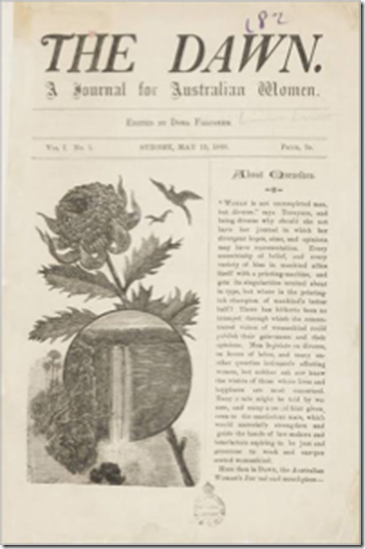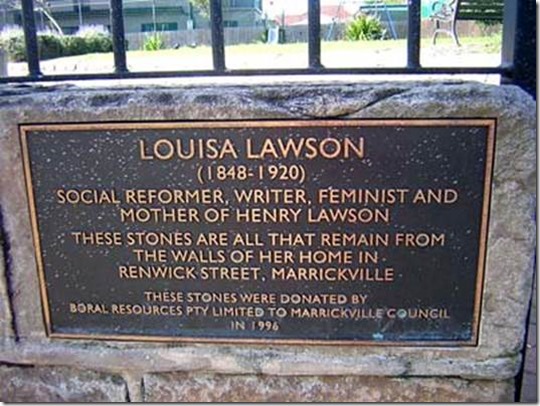Originally posted on February 21, 2021 @ 3:31 PM
The Visionary Imagination – Louisa Lawson
Following a week of lies, criminal cover ups and misogynistic performance by the Australian Prime Minister we see yet again the demonization of women by the face of masculinist orthodoxy . If ever we needed visionaries like Louisa Lawson, it is today. Strange how orthodoxy always hides behind traditionalism (https://safetyrisk.net/traditional-safety/) to do its bidding of keeping women in their place. Louisa demonstrates that visionaries reject stasis and zero, and all semiotics of masculinist power.
The following is a selection from Chapter 3 of the book Envisioning Risk (https://www.humandymensions.com/product/envisioning-risk-seeing-vision-and-meaning-in-risk/).
Louisa Lawson (1848-1920)
Louisa Lawson was one of the first feminist radicals in Australian History. Her husband Peter died leaving Louisa with £1103 so she bought a paper called The Republican. Soon Louisa, established the first journal for Women in Australia called ‘Dawn’. Louisa was a suffragette and most industrious, and Dawn soon had 10 female employees including 2 female printers
The New South Wales Typographical Association (NSWTA) (comprising all men) tried to close Louisa down because women were unwanted in the industry. Louisa countered the power of the NSWTA by seeking support from the Trade Union Movement. Louisa demonstrated throughout the 1890s her amazing insight, ingenuity, inspiration and vision. She did well at anything she put her hand to. Except His-story pushes women like Louisa to the background and foregrounds males of the time who were far less influential than her. It was also a time that if a woman thought of something, invented something or demonstrated any sense of vision, she would be smashed by orthodoxy, traditionalism and patriarchy.
In 1889 Louisa formed the Dawn Club in Australia, the first association for female suffrage. Of course, Dawn is symbolic for the Millennial Dawn, an apocalyptic hope for a new era and Louisa was one of the first female socialists – feminists.
Louisa had a vision that one day women would get the right to vote. The fortresses of masculinist power and self-interest were rallied against her. The image of the first edition is at Figure 1. The Dawn.
Figure1 The Dawn
Louisa was instrumental in Womanhood Suffrage League of New South Wales formed in 1891. Her son Henry published his first volume of verse in Dawn in 1894. Who knows where Henry would have gone if it were not for that opportunity. In 1892 Louisa and others campaigned to the Premier to ‘redeem the world from bad laws passed by wicked men’.
The Dawn magazine was published every month advocating feminist ideas, discourse and interests and continued for 17 years. The Dawn was more than a magazine, it was a movement and focal point that offered women Hope, Love, Faith and Justice, that one day they might be considered equal, including having the right to vote. Although Louisa couldn’t enter politics she was a powerful political force at the time with associations with the Labor movement, Worker’s parties, Union and Socialist Groups that were all being formed at the time.
Louisa did all of her work whilst also running a household of 6 children and a husband who was violent and unreliable. Louisa left her husband Peter after 20 years marriage in 1883 and went to Sydney.
After being thrown off a tram and breaking her spine Loisa recovered and in 1902 joined the Women’s Progressive Association to continued her political campaign. Unfortunately, her accident took a toll and Dawn closed in 1905 but saw in 1902 the day that Women got the right to vote. South Australia gave women the vote in 1894 and Western Australia in 1899, and by 1911, the remaining Australian states had legislated for women’s suffrage for state elections.
The following tale captures the nature of paternalistic culture and the nature of victimisation of visionaries by the powers of traditionalism and orthodoxy.
In 1896 Louisa, with considerable experience in the Post Office and publication, developed a buckle mechanism to replace the strapping process used at the time to seal mail bags. Louisa wasn’t so much of an inventor as a pragmatist, and if there was an agenda, maybe it was that she could do something as good as any man.
Her invention was immediately adopted by the Post and Telegraph Office with due acknowledgement that it saved time and money. Loisa took out a patent on the design and received very little money for her service. Similarly, it was expected that women were NOT entrepreneurs or visionaries and should not infringe on male domains. She had already been supplying the fasteners to Government Department for 4 years and with Federation approaching could have earned up to 1000 pounds a year for her invention. But almost immediately trouble arose. In 1900 Edward Nicol Murray without consent started making a replica and the Post Master General’s buckles who gave a contract (for 5000 fasteners) to him. Ah, ‘Jobs for the boys’ club.
Lousia opposed the patent application by Murray and he withrew his claim but continued to manufacture his product and sell it. It was about this time Louisa had her accident and it took her 2 years to recover. The case went to court, another male domain, and after a year the magistrate ruled that Murray’s design was an infringement of Louisa’s patent. She received 250 pounds in damages, far less than what her product would have saved the Department. Then the news came, the new Federal Government had given the contract to Murray outside of the jurisdiction of her patent (NSW ). She proceeded with court action again but lost and so her work had been thwarted by politicians, orthodoxy and males, yet again.
Lousia was an accomplished poet, writer and business woman. Before she started The Dawn she wrote for and managed The Republican. Louisa’s writing was sophisticated, radical and original. She didn’t just offer hope in verse but was articulate in captivating any cause of injustice, inequity and/or corruption. From the first issues of The Dawn, Lawson included a Poet’s Page. She also released her own book in 1904 The Lonely Crossing and Other Poems. It was not published again until 1996.
Louisa’s poetry discussed issues of masculinity, femininity, love, marriage, and the dangers that alcohol and sexual abuse posed to women. Her poetry is very much feminist poetry and in it she demonstrates that she knows all about risk, particularly in poems like ‘The Flower and the Book’ (which reflects the trope of the fallen woman), ‘Song of Bacchus’, and ‘To a Libertine’.
Louisa was also involved in the Women’s Christian Temperance Union that was founded in the 1891 and identified with any cause or movement that upheld the ethical and moral dignity of women. Apart from women’s political rights, the WCTU, from its foundation has been committed to children and women’s welfare.
In her poetry, as with Henry, Louisa’s focus is often on spiritual themes and after death experience. In 1877 Louisa had lost one of her twin daughters to gastroenteritis and this had a profound effect on her. Louisa found solace in her poetry and wrote:
With rapture I gaze for by faith do I see
The child that my saviour has taken from me
Secure in His arms in that beautiful place
Many of Louisa’ poems involve a similar sense of communication beyond the grave. Her use of both Psyche and Bacchus in her poetry reflects feminist concerns with marriage and temperance. Her concerns with marriage, the soul, and Eros, are all highly significant themes of Louisa’s feminist poetics and political reform. The fallen woman is symbolised by flowers in many of Lawson’s poems including ‘The Common Lot’ and ‘The Flower and the Book’.
Louisa’s poems capture all that is critical in the prophetic imagination and the Faith-Hope-Love-Justice dialectic.
We know that the Theosophists were strong in Sydney from 1880 to 1939. Roe gives insight into the Spiritualist leanings of Louisa, in Beyond Belief: Theosophy in Australia 1879–1939, commenting that:
‘A spiritually distressed Louisa Lawson learned ‘Zooistic Science, Free Thought, Spiritualism and Harmonial Philosophy’ all together from a Spiritualist organisation in Sydney during the ‘Free thought craze’ of the 1880s’
It was Theosophy that promoted the idea of Lemuria. The founder of Theosophy Madam Blatavsky, argued that the lost land of Lemeuria (think Atlantis) was Australia. It was this focus on Australia as Lemeuria that fueled Theosophists boom in the country and the idea to redeem Australia spiritually.
There were concerns at the time that the Women’s Suffrage League was too closely aligned with Theosophy. Spiritualist ideas were linked closely with marriage reform and free love. Spiritualism was also associated
with socialist politics, radicalism and Union leaning associations and papers. Similar associations can be found in post-structuralist feminism today. Louisa whilst brought up as a strict Methodist but had dabbled in the occult and seances when she lived in Mudgee.
The final issue of The Dawn carried ‘An Explanation’ that because of the legal case she had been involved in (over the belt patent) she had been slandered and persecuted (by men) and had suffered too much and her health was failing.
Unfortunately, Louisa died in lonely and impoverished circumstances but her legacy lived on through the inspirational verse of her own as ‘Dolley Dear’, and through the work of her son Henry.
Louisa stood up against forces much greater than herself and modelled to Henry a vision for a new dawn. A park in Marrickville, New South Wales is named after her (see Figure 2. Louisa Lawson’s Memorial).
The Louisa Lawson Reserve contains a large colourful mosaic depicting the front cover of The Dawn, and a plaque that reads:
‘Louisa Lawson (1848–1920) Social Reformer, writer, Feminist and Mother of Henry Lawson’.
In all my research on Australian visionaries I could find none who were not ‘political’ yet not politicians. All visionaries call out against the nature of power and advocate for most victimized. Often visionaries like Louisa are demonsised and vilified because they won’t get into bed with Orthodoxy. You can read more about Louisa here: Ollif, L., (1978) Louisa Lawson, Henry’s Crusading Mother. Rigby.Adelaide.
Keeping to stasis favours the privileged and keeps everything safe. Stepping outside regulation, orthodoxy and bureaucracy embraces risk and enters into the social contract (https://www.iep.utm.edu/soc-cont/ ), this is where real decision making takes place. This is where real vision and imagination is found that thinks of a new, different, humanised and better future in the Faith-Hope-Love-Justice dialectic.





Do you have any thoughts? Please share them below